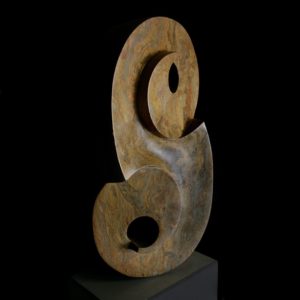
Home » Carve » Soft Stone » Limestone – May/June 2009
 White, creamy limestone has been a staple of Pacific Northwest sculptors since 1992 when 6 tons of Utah oolitic found its way to the Northwest Stone Sculptors 5th annual carving symposium. It owes its continued popularity (10 tons at the 1993 symposium and many more tons subsequently) to its ease of carving, low cost and wonderful finished demeanor. It is indeed a “poor man’s marble,” both genetically and artistically. With sweeping curves and shapes, limestone casts beautiful shadows and interesting lines.
White, creamy limestone has been a staple of Pacific Northwest sculptors since 1992 when 6 tons of Utah oolitic found its way to the Northwest Stone Sculptors 5th annual carving symposium. It owes its continued popularity (10 tons at the 1993 symposium and many more tons subsequently) to its ease of carving, low cost and wonderful finished demeanor. It is indeed a “poor man’s marble,” both genetically and artistically. With sweeping curves and shapes, limestone casts beautiful shadows and interesting lines.
Geology
Limestone is a rock that contains 50 percent or more calcite (calcium carbonate, CaCO3) and dolomite (magnesium calcium carbonate, MgCaCO3), of which calcite is dominant. It is the sedimentary parent of the metamorphic rock, marble. In very simple terms, it is a rock from which lime can be produced. Although it is defined chemically, the calcium carbonate can be formed in more than one way:
The most commonly utilized limestone is oolitic or compact limestone that is formed from marine oolites or ooliths. Ooliths are small round or oval bodies, 0.25 to 2 millimeters in diameter that form concentric circles and/or radii of calcium carbonate around a nucleus by chemical precipitation. The nucleus may be a shell fragment, a small piece of algae, or a quartz sand particle. It is important that the oolith be continuously wave or current agitated, so concentric growth can continue.
The ooliths eventually become heavy enough to settle to the ocean floor, accumulate in thick layers, and over geologic time, through the pressure of the overburden, form limestone that is relatively compact and uniform. Just imagine; all those oolites huddled together at the bottom of the ocean waiting to be discovered by a stone supplier. Their growth is similar to the growth process of a hail stone. Another type of precipitate is travertine, in which calcium carbonate precipitates out of a cave of spring water and forms interestingly shaped and colored rock. Among others, this is the type of rock that forms stalagmites and stalactites in caverns. This rock typically contains voids, because of the irregular way in which it is deposited. Biologically formed limestone includes tufa, which are small calcium carbonate secreting fresh-water organisms, and reef-building corals. Both of these rocks are beautiful in their natural state, but are not considered to be carving stones.
Limestone can be found in several colors: white, brown, red, and yellow. Although the hardness of this rock can vary from very soft (1) to the hardness of 6, the most common carving limestone is about 3 to 4. The dominant mineral is calcite, with secondary dolomite and aragonite, but there are small quantities of chalcedony, quartz and other silicates.
Limestone is one of the most susceptible rocks in the world to chemical weathering; for instance, consider the fact that all of the great caverns in the world are carved by Mother Nature’s groundwater from limestone. Sculptures and building stones of limestone are particularly vulnerable to degradation in areas with acid
rain.
Limestone has a wide variety of uses other than artistic. It is used as crushed stone for roads and embankments, a dimension stone, a fluxing agent for smelting and refining iron and other metals, a component in plaster and mortar, in the production of chemicals, an ingredient in paper and glass making, a soil conditioner, a water softener and most importantly, the prime ingredient in cement.
Working Limestone
Because there are so many types of limestone, it is difficult to describe the carving of all of them. The softer limestones, especially those that are biologically formed, such as tufa and coral, are not used for carving, because they are fragile and brittle. Although weak corals are not useful for carving, some beautiful metamorphosed (fossilized) corals can be carved with diamond power tools. The coral designs are spectacularly preserved in the limestone.
Travertine can be an attractive stone for sculpture with its random voids. The voids can fit into the piece or just add to the ambiance of it. The voids do cause complications in the working of the stone. It becomes very problematic to work this stone with hand tools, because chisels create spalling around the edges of the natural holes in the stone or they may open up new holes that are just below the surface. Once these holes are rendered ragged by chisel marks, they are very difficult to erase, because they are below the working surface. It is essential to work this stone with power tools, preferably grinders and burrs.
Oolitic limestone is a perfect stone for beginners and expert alike. Because of the uniform method in which it is laid down, it has uniform color and hardness. It has very few surprises; something to be prized! Although it may contain some scattered iron sulfide or quartz, it is mostly pure carbonate or dolomite. The few joints or cracks in the stone can be exploited when breaking the stone into smaller pieces. Fortunately, upon careful scrutiny, even hairline cracks can normally be spotted in oolitic limestone.
This limestone can be worked with hand or power tools. Roughing out the form can be accomplished with a point, and then followed with a toothed chisel to within 1/2 to 1/8 inch of the finished surface. The grooves of the toothed chisel can then be eradicated with a flat chisel. With various grades and shapes of rasps, the final touches can then be applied. Surface smoothing can then proceed by using 200 to 400 grit wet-dry sandpaper. Paper finer than 400 grit yields very little return for the effort.
Texturing can be applied to oolitic limestone with wonderful results with a bushing hammer or tool and a toothed chisel. Using a carbide-tipped drill bit for a base pin hole, the limestone cuts like butter; be careful not to drill too deeply.
Although some limestones may be able to take the outdoors year-round, it is probably not advisable as a blanket practice. Owing to its moderate porosity; it can absorb water and suffer from freeze-thaw. A sealant is commonly applied in two coats to prevent penetration of water. As mentioned above, in the long-term, it is one of the most vulnerable of stones to acid rain attack.
Similar to marble, there are many reports regarding the benign dust of calcium carbonate-bearing limestone. However, don’t be too cavalier, because there are impurities, one of which is silica. So be safe and wear a mask, and keep your goggles on. You have only one pair of eyes.







We need some kind of descriptive text here.